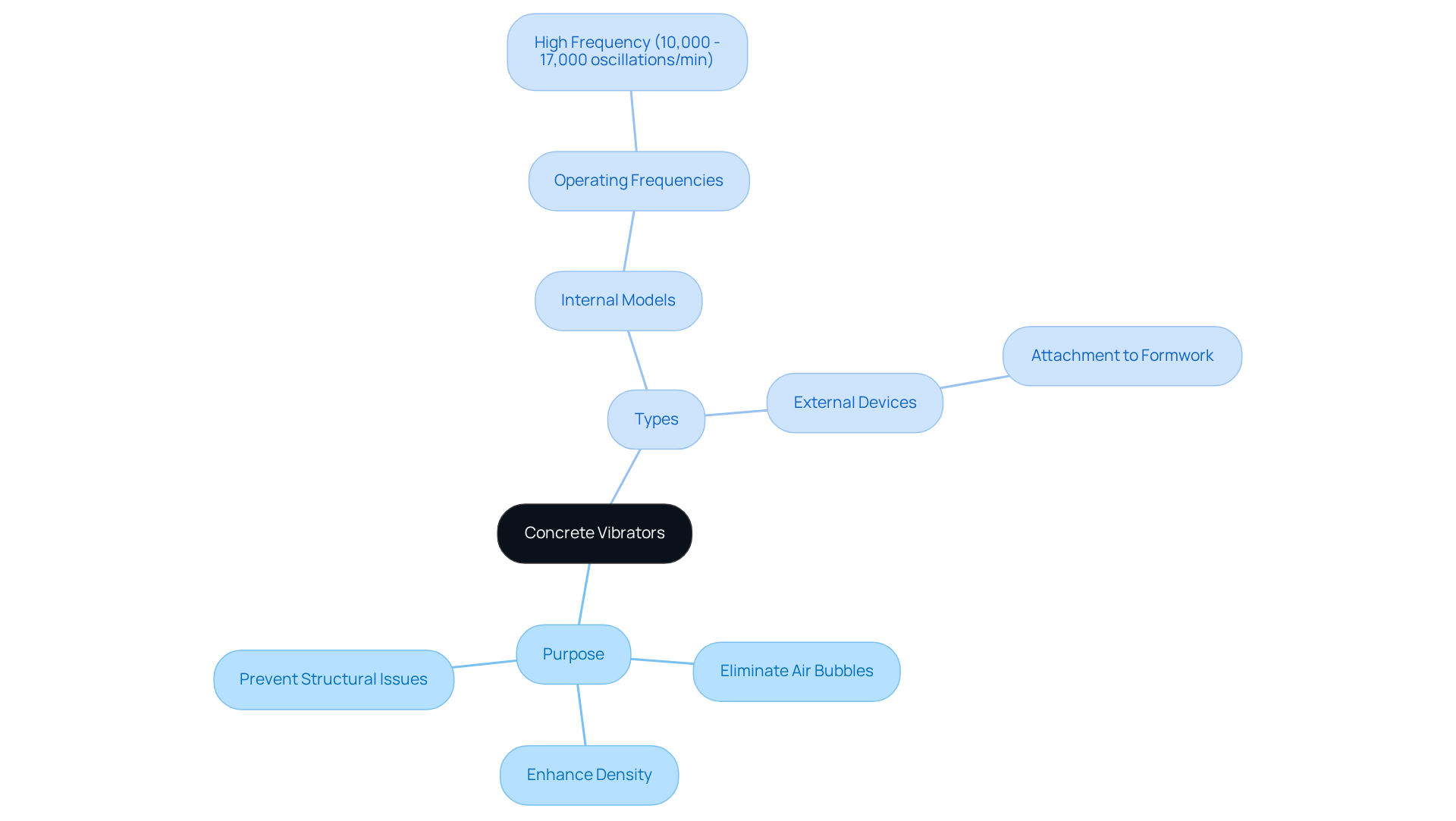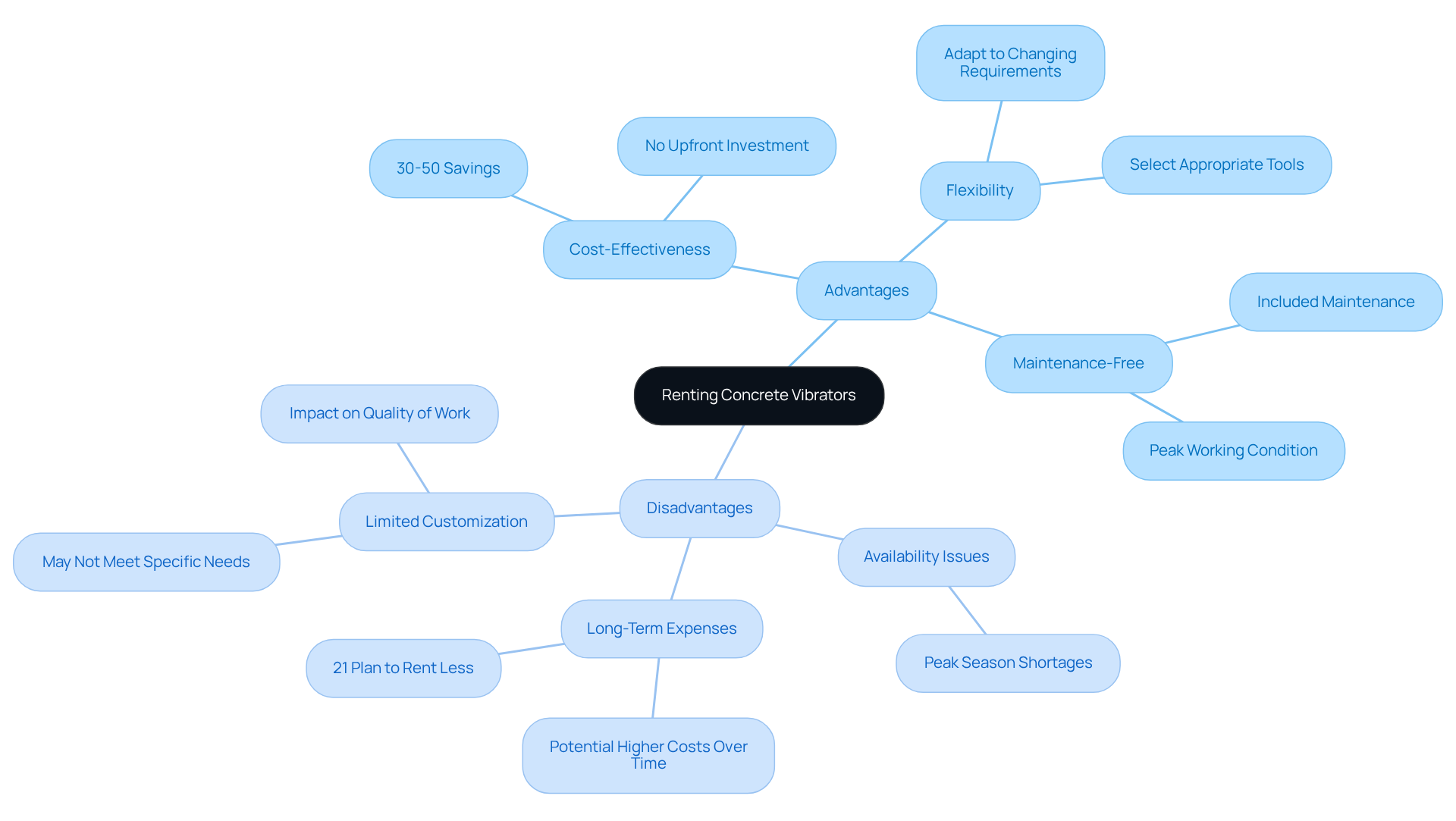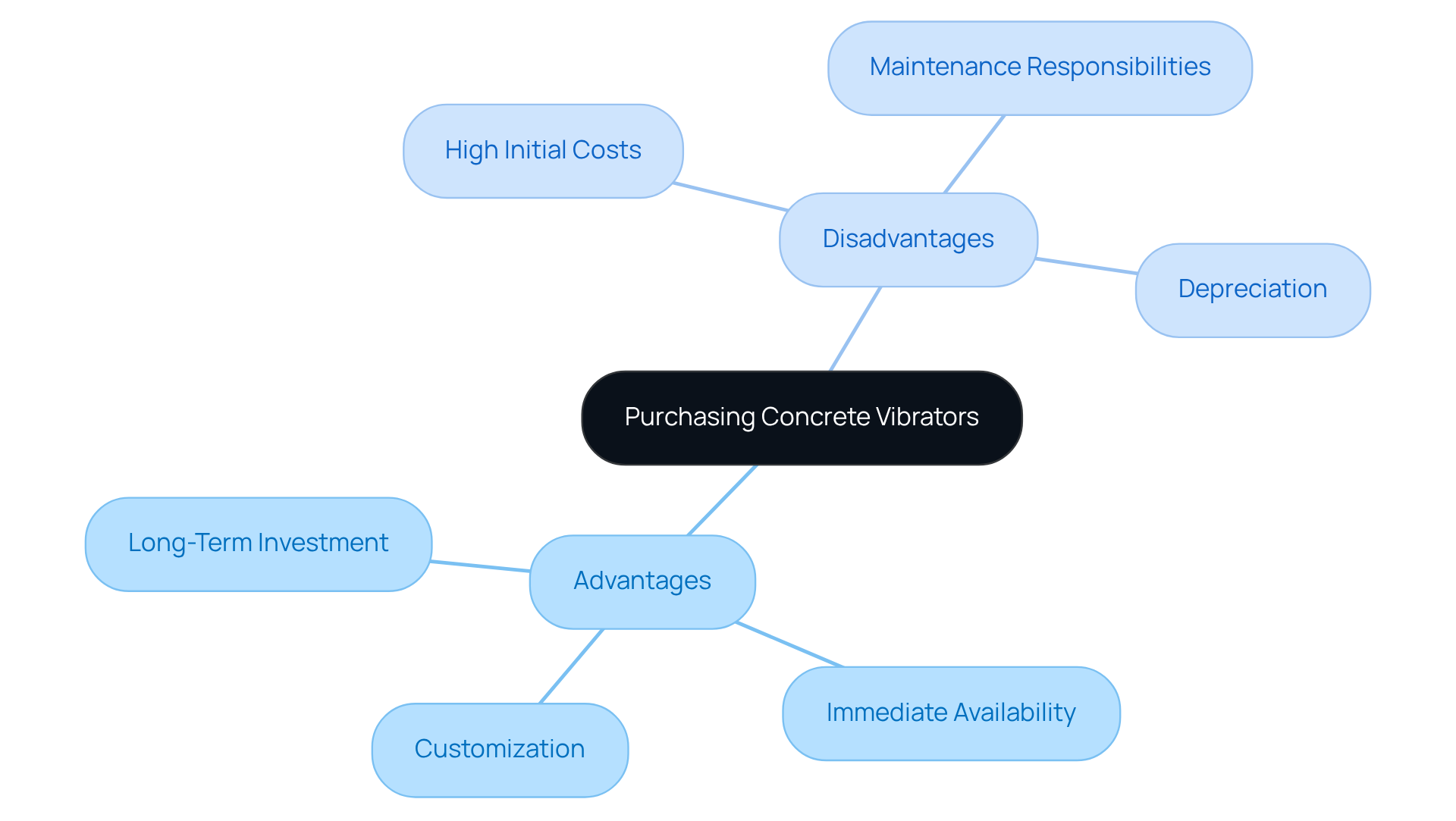Overview
The article examines a critical question: should project managers rent or purchase concrete vibrating tools? It asserts that renting proves to be more cost-effective for short-term projects, whereas purchasing aligns better with long-term needs. This conclusion is substantiated by a thorough analysis of the financial implications, flexibility, and maintenance responsibilities inherent in both options. Moreover, it highlights how factors such as project duration, budget constraints, and specific equipment requirements significantly influence the decision-making process. By understanding these dynamics, project managers can make informed choices that optimize their operations.
Key Highlights:
- Concrete vibrators eliminate air bubbles in freshly poured mixtures, enhancing density and durability.
- Types of concrete vibrators include internal (immersion) and external devices, operating at different frequencies.
- Effective use involves withdrawing the device from the surface at about 1 inch per second to prevent air pockets.
- Electric cement oscillators are eco-friendly, producing zero emissions, supporting sustainable building practises.
- Renting concrete vibrators is cost-effective for short-term projects, saving 30-50% on ownership costs.
- Renting offers flexibility and maintenance-free operations, but may face availability issues and long-term expense concerns.
- Purchasing vibrators is a long-term investment, providing immediate availability and customization but entails high initial costs and maintenance responsibilities.
- Project duration, budget constraints, equipment needs, and maintenance capacity are key factors in deciding between renting and purchasing.
- The construction equipment rental market is projected to grow, indicating a trend towards renting due to economic factors.
Introduction
Navigating the decision between renting or purchasing concrete vibrating tools represents a critical crossroads for project managers in the construction industry. These essential instruments not only enhance the quality of concrete but also significantly impact project efficiency and cost management. As the construction landscape evolves, understanding the advantages and drawbacks of each option becomes paramount.
- Will the flexibility and lower upfront costs of rental outweigh the long-term benefits of ownership?
- Or will a tailored approach to equipment acquisition emerge as the optimal strategy?
The choice you make today will shape your project’s success.
Understanding Concrete Vibrators: Purpose and Functionality
Vibrators for cement are essential instruments designed to eliminate air bubbles from freshly poured mixtures, resulting in a denser and more durable final product. By generating vibrations, these tools enable the mixture to flow more freely, facilitating the escape of trapped air. This crucial process prevents issues such as honeycombing and weak areas in the material, which can jeopardize structural integrity.
Various types of concrete oscillators are available, including:
- Internal (or immersion) models that are inserted directly into the concrete
- External devices that attach to the formwork
Internal devices typically operate at elevated frequencies of 10,000 to 17,000 oscillations per minute, while low-frequency models function between 5,000 to 9,000 oscillations per minute. Understanding these functionalities allows project managers to choose the most suitable option for their specific needs, whether through concrete vibrating tool rental or outright purchase.
For optimal results, it is recommended to withdraw the device from the surface at a rate of approximately 1 inch per second. As highlighted by industry specialists, the effective use of cement mixers significantly enhances the quality of the final structure, ensuring compliance with necessary standards for strength and durability.
Furthermore, electric cement oscillators offer environmental benefits, including zero emissions, making them a preferred choice in sustainable building practices. By investing in the right equipment, you can ensure the success of your construction projects while contributing to a greener future.

Advantages and Disadvantages of Renting Concrete Vibrators
Renting a concrete vibrating tool rental offers significant advantages, particularly for project managers overseeing short-term projects. The key benefits are as follows:
- Cost-Effectiveness: Renting negates the need for a substantial upfront investment, making it a financially sound choice for one-off jobs. This strategy can save companies 30-50% of total ownership costs, especially considering that the average rental duration for construction equipment typically hovers around two weeks.
- Flexibility: Project managers can select the appropriate type of vibrator for specific tasks without the obligation of ownership. This adaptability is crucial, especially when project requirements evolve.
- Maintenance-Free: Rental agreements usually include maintenance, relieving teams of the upkeep burden and ensuring that equipment remains in peak working condition.
Nevertheless, there are drawbacks to consider:
- Availability Issues: During peak seasons, certain models may be unavailable for rent, potentially hindering project timelines.
- Long-Term Expenses: For projects necessitating prolonged use, renting may become more expensive than purchasing over time. Notably, 21% of construction firms plan to lease tools less frequently, and 42.9% prefer to rent less as they aim to invest in ownership for long-term projects.
- Limited Customization: Rental tools may not always meet specific assignment requirements or preferences, potentially impacting the overall quality of work. Project managers often find that owning their tools allows for customized solutions that better align with their needs.
In practice, many managers have indicated that renting tools enables them to adapt swiftly to changing requirements. For instance, a manager overseeing a large-scale construction site noted that concrete vibrating tool rental allowed them to manage varying workloads effectively without the financial strain of outright tool acquisition. This flexibility is essential in the dynamic construction environment, where specifications can shift rapidly. Furthermore, insufficiently vibrating materials can lead to air pockets, resulting in weaker mixtures and costly rework, underscoring the importance of utilizing the right tools efficiently.

Advantages and Disadvantages of Purchasing Concrete Vibrators
Acquiring a concrete vibrating tool rental represents a strategic investment for managers engaged in ongoing concrete tasks. The benefits are substantial:
- Long-Term Investment: Owning equipment proves to be more cost-effective over time, particularly for projects requiring consistent use. A study indicates that acquiring heavy construction machinery not only provides future asset value growth but also results in significant long-term cost savings.
- Immediate availability of concrete vibrating tool rental ensures that vibrators are readily accessible, allowing teams to initiate work without delays associated with this rental. A recent survey reveals that 21% of construction companies intend to rent equipment less frequently, highlighting a trend toward ownership.
- Customization: Ownership enables managers to select specific models tailored to their unique requirements and preferences, thereby enhancing operational efficiency.
However, there are important disadvantages to consider:
- High Initial Costs: The upfront investment can be considerable, potentially straining project budgets.
- Maintenance Responsibilities: Owners are tasked with managing maintenance, repairs, and storage, which can elevate operational costs. As demonstrated in a case study, effective equipment management is vital for minimizing these expenses.
- Depreciation: The value of equipment declines over time, which can affect financial planning and asset management. This factor is crucial for managers to evaluate when formulating their long-term strategies.
Understanding these factors is essential for managers to make informed decisions that align with their operational objectives and financial constraints. Take action now to assess how a concrete vibrating tool rental can enhance your project efficiency and cost management.

Making the Right Choice: Rental vs. Purchase Based on Project Requirements
When determining whether to opt for a concrete vibrating tool rental or to purchase concrete vibrators, project managers must evaluate several key factors that can significantly impact project success.
- Project Duration is a crucial consideration. For short-term projects or one-off tasks, opting for concrete vibrating tool rental often proves to be the most cost-effective option. Conversely, for extended endeavors that require consistent tool usage, purchasing may ultimately demonstrate greater cost-effectiveness over time.
- Budget Constraints also play a vital role in this decision. It is essential to assess the available budget and compare the total cost of ownership—including maintenance, storage, and depreciation—against the costs of concrete vibrating tool rental throughout the project's duration. Notably, the construction equipment rental market, which encompasses concrete vibrating tool rental, is projected to grow at a CAGR of 4.66% from 2025 to 2033, indicating a rising trend towards renting due to favorable economic factors.
- Equipment Needs should not be overlooked. Understanding the specific requirements of the project is critical; if specialized vibrators are necessary, purchasing may provide a wider range of tailored options to meet those needs.
- Maintenance and Storage considerations are equally important. Teams must evaluate their capacity to manage maintenance and storage for owned assets. Leasing a concrete vibrating tool rental can alleviate these responsibilities, allowing teams to focus on executing tasks effectively. As Josh Nickell, Vice President of the American Rental Association, emphasizes, effective planning and analytics are vital in equipment management to eliminate guesswork.
Ultimately, the decision should align with the project's objectives, financial limitations, and operational capabilities. By carefully weighing these factors, project managers can ensure that their chosen method effectively supports successful project outcomes.

Conclusion
Choosing between renting or purchasing concrete vibrators is a pivotal decision for project managers, significantly influencing the success and efficiency of construction projects. Understanding the specific needs of each project, along with the financial implications of both options, is crucial. By carefully evaluating these factors, managers can make informed choices that align with their operational goals.
Renting offers immediate cost savings and flexibility, particularly beneficial for short-term projects. In contrast, purchasing vibrators can be more economical for long-term use and provides the advantage of customization. Each approach has its merits and drawbacks, emphasizing the necessity for a tailored strategy based on project duration, budget constraints, and equipment requirements.
Ultimately, the decision between concrete vibrating tool rental and purchase should reflect a comprehensive assessment of project demands and financial capabilities. By embracing a strategic approach, project managers can enhance their operational efficiency and ensure the successful execution of their construction endeavors. Take action now to evaluate your options and optimize your project outcomes.
Frequently Asked Questions
What is the purpose of concrete vibrators?
Concrete vibrators are essential tools designed to eliminate air bubbles from freshly poured concrete mixtures, resulting in a denser and more durable final product.
How do concrete vibrators work?
They generate vibrations that allow the concrete mixture to flow more freely, facilitating the escape of trapped air and preventing issues such as honeycombing and weak areas in the material.
What types of concrete vibrators are available?
There are two main types of concrete vibrators: internal (or immersion) models that are inserted directly into the concrete and external devices that attach to the formwork.
What are the operating frequencies of internal concrete vibrators?
Internal concrete vibrators typically operate at elevated frequencies of 10,000 to 17,000 oscillations per minute, while low-frequency models function between 5,000 to 9,000 oscillations per minute.
What is the recommended withdrawal rate for using a concrete vibrator?
It is recommended to withdraw the concrete vibrator from the surface at a rate of approximately 1 inch per second for optimal results.
What are the benefits of using electric cement oscillators?
Electric cement oscillators offer environmental benefits, including zero emissions, making them a preferred choice in sustainable building practices.
How can the use of concrete vibrators impact construction projects?
The effective use of concrete vibrators significantly enhances the quality of the final structure, ensuring compliance with necessary standards for strength and durability, ultimately contributing to the success of construction projects.




